| Columns Retired Columns & Blogs |
Not that it matters much or at all....
Was it Mike Moffat or Paul McGowan ?
These two pioneered Audiophile DACs and continue as Leading "Higher Authorities".
Tony in Venice
Unlike the very high output levels of other Theta products, the Cobalt 307 DAC had a maximum output of 2.027V (left channel) and 2.059V (right). This is very close to the 2V CD standard. Output impedance was 50 ohms across the band. This low value suggests the 307 DAC should have no trouble driving a power amplifier through a passive level control.
Frequency response and de-emphasis error are shown in fig.1. The right channel's 0.3dB higher output can be seen in the top trace. There is less HF rolloff than is usually measured in digital processors; the 307 DAC is down only a tenth of a dB at 20kHz. De-emphasis error (bottom traces) was virtually nonexistent, owing to the fact that it is performed in the digital domain by the Sony digital filter.
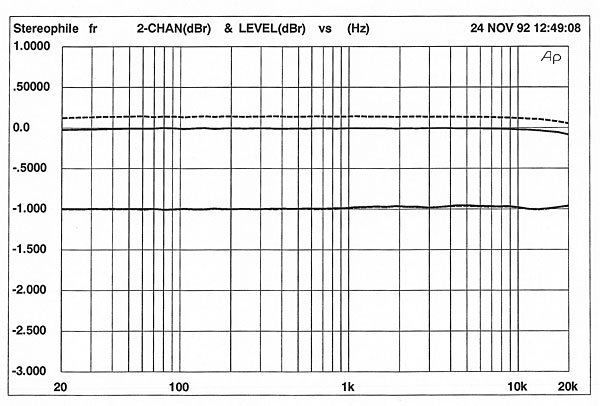
Interchannel crosstalk (fig.2) was unusual in that channel separation decreased at low frequencies. Most crosstalk curves show the inverse of the 307 DAC's response, with crosstalk increasing with frequency. Note that left- and right-channel separation performance is virtually identical.
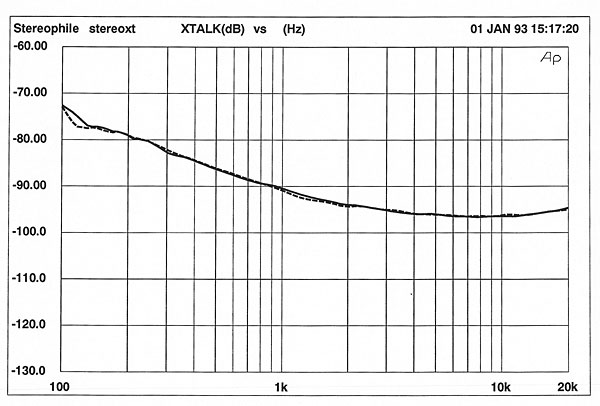
Looking at a 1/3-octave spectral analysis of the 307 DAC when decoding a –90dB, dithered 1kHz sinewave (fig.3), we can see a fairly high level of power-supply noise at 60Hz. This is, however, to be expected when the power transformers are located so close to the audio circuitry. Interestingly, there is some 120Hz in the right channel (dotted trace) not seen in the left channel. This noise is also seen in fig.4, a similar spectral analysis of the 307 DAC when driven by digital silence (all data words are zero). Note that fig.4 is plotted to 200kHz, and that there are no spikes that would indicate DAC idle tones or other artifacts.
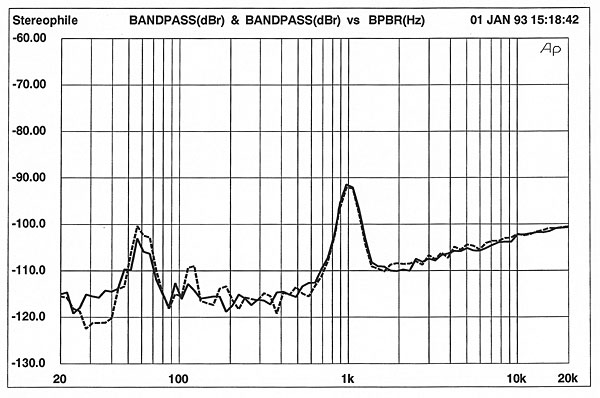
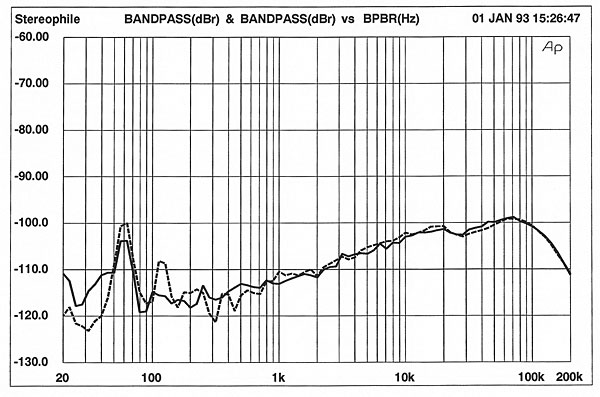
Low-level linearity (fig.5) was only fair, with a 4dB negative error at –90dB in the right channel. The low-bit operation of the PCM67 on low-level signals would be expected to produce less linearity error than is seen here.
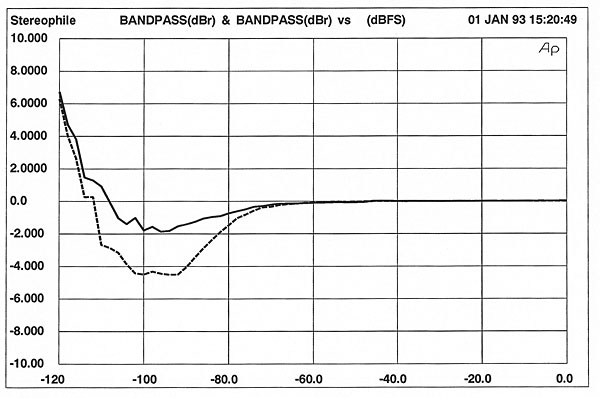
The 307 DAC's noise modulation performance was excellent, as seen in fig.6. The traces are very closely grouped, particularly above 2kHz. This indicates that the noise floor's spectral balance will shift very little as a function of input level. This was good performance, considering the mediocre linearity measurement; the two are closely related.
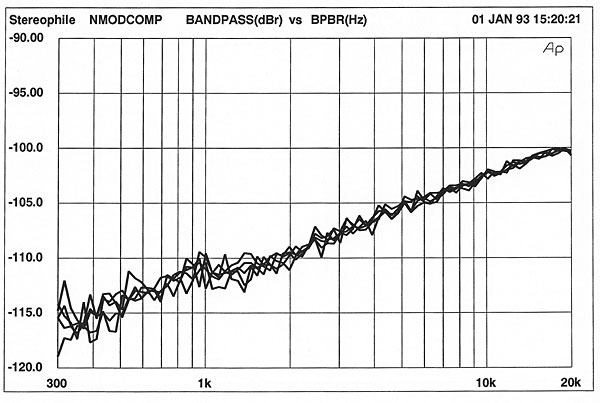
The waveform produced by the 307 DAC when decoding a –90dB, undithered 1kHz sinewave is shown in fig.7. There is a fairly high level of audioband noise on the signal, and the waveform looks rather raggedy.
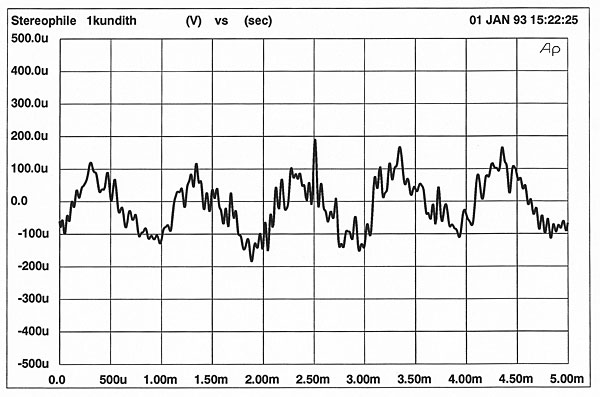
Fig.8 is an FFT-derived spectral analysis of the 307 DAC's output when driven by a full-scale mix of 19kHz and 20kHz. There is a remarkable absence of a 1kHz difference component, but there are several higher-order intermodulation components at 2kHz, 7kHz, 9kHz, 15kHz, 16kHz, and 17kHz. There is also an unusual rise in the noise floor centered on the test-signal frequencies. To explore this behavior, I repeated the analysis using different test-signal frequencies (not shown). As with the 19kHz and 20kHz analysis, there was a noise-floor rise at the frequency of the test signal. This rise was, however, greater at high frequencies, but maintained approximately the same bandwidth.
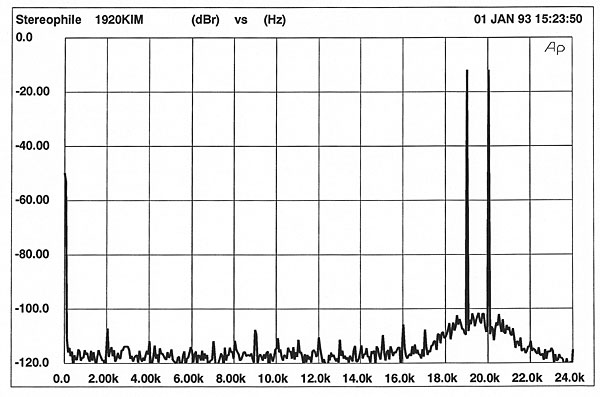
The 307 DAC's reproduction of a full-scale, 1kHz squarewave is shown in fig.9. The clipped shape is typical of linear-phase digital filters such as the Sony CXD1244.
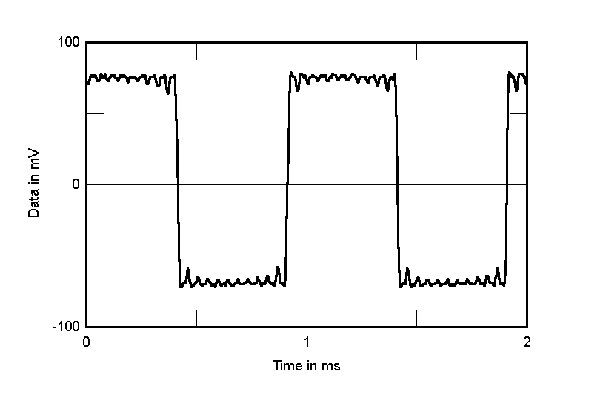
As would be expected from Theta, the 307 DAC's jitter performance was good considering the unit's low price. The jitter level varied from 118ps (with no input signal) to 364ps (worst case, –90dB, 1kHz sinewave input). The jitter was less than 300ps with signal levels above –30dB. The Cobalt's jitter spectrum is shown in fig.10 (driven by a full-scale, 1kHz sinewave) and fig.11 (driven by a –70dB, 1kHz sinewave). Note the spikes at 1kHz and multiples of 1kHz, indicating the jitter is periodic and correlated to the input signal. Also note how the number of discrete-frequency jitter components rises with the lower input level. All jitter measurements were made at the 8fs (352.8kHz) clock pin on the PCM67 chip.
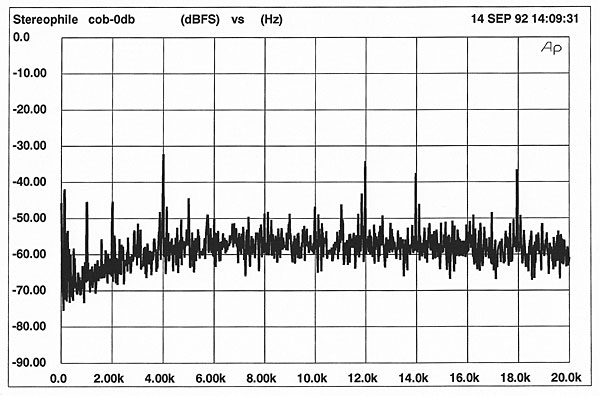
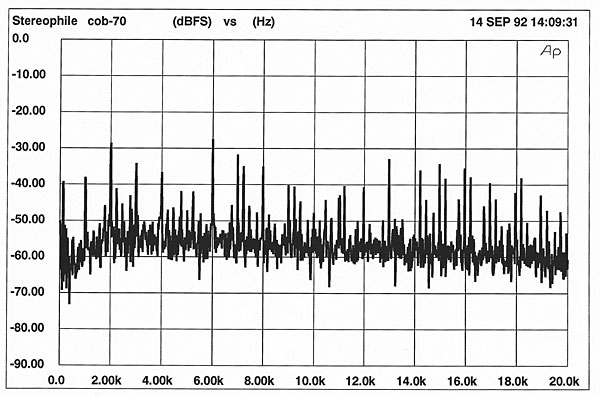
The 307 DAC had no problem locking to 32kHz and 48kHz sampling frequencies, and I measured less than 100µV of DC offset at the outputs, a very low level. Finally, the unit doesn't invert absolute polarity unless the front-panel polarity button is depressed.
Overall, the 307 DAC's bench performance was good for its price.—Robert Harley

Not that it matters much or at all....
Was it Mike Moffat or Paul McGowan ?
These two pioneered Audiophile DACs and continue as Leading "Higher Authorities".
Tony in Venice

... "good for its price" sounds like damning it with faint praise.
You'd have been much better off buying one of the higher end Sony ES CD players from that era.

Not that it matters much or at all....
Or Arcam or Musical Fidelity in the UK?
Was it Mike Moffat or Paul McGowan?
Paul McGowan in the US. But what's interesting about the Cobalt DAC is that it was designed by Jason Stoddard, then with Sumo, and now better-known as the cofounder of Schiit Audio.
Good to see you back, Tony.
John Atkinson
Technical Editor, Stereophile

"Who was first?" (The Dawn of Commercial Digital Recording)
http://www.aes.org/aeshc/pdf/fine_dawn-of-digital.pdf

Today, in digital audio, the technology is rather well understood, and it would be a long list of 'higher authorities'.
For the modern variant, high quality digital audio over IP, I would highlight the name Kevin Gross (AES Fellow, invented CobraNet, chaired the AES67 working group and did most of the heavy lifting, etc., extending to a long depth of work and list of accomplishments).

Well, he seems to be talking to the Pro People more than we hobbyists. Can't complain about that too much because I don't know the first dam thing about 192 and beyond, I'm a Loyal 16/44 Redbook fan.
If I could...
I'd ask Mr. Gross how a $100,000 DAC delivers superior playback sound quality from Music recored by ProAudio ADCs costing far less and often not featuring any of the magic pixie lust dust included in those 2 chassis Sculptures ?
anyway...
Thanks for writing about all this.
Tony in Venice

Thanks for stepping up for our Brits with their earliest DAC contributions.
I was a bit worried that you might disappear to Bermuda or join the growing number of NarrowBoat Retirees cruising the Cut. ( like I'm contemplating )
Something you wrote over the Summer reminded me of your considerable skill & lexicon. Mr. Austin's writing seems to further establish Stereophile's sound Management principals are being kept in a World where Outfits like Boeing are cutting cost corners at the expense of Quality.
I'm delighted they're not squeezing you out. ( redundant ? , god forbid )
Tony in Venice
ps. Mr. Stoddard doesn't seem to crave a "First DAC" title. Maybe being First is just an Asian sort of thing ( other than Drag Racing, of course )

Mr. Atkinson seems to hide in his 'safe space' more often these days ...... Just kidding :-) ........

Tony, please don't disappear in the 'Bermuda Triangle' :-) ........

that was a close one for me,
Bahamas we're destroyed which included quite a few retired Brits.
Tony in Venice


When he retires, JA1 is gonna live in his own private island like, Sir Richard Branson. Bill Gates, Mark Zuckerberg, Leonardo DiCaprio and some other wealthy individuals :-) .........

Of course, just like those wealthy individuals, JA1 is gonna own his own private jet and private yacht for his transportation needs :-) .......

Liked it quite a bit.. little chalky and dense, but it was fun! Now, this level of quality is pretty laughable.. marginal, incremental improvements over a standalone CDP.